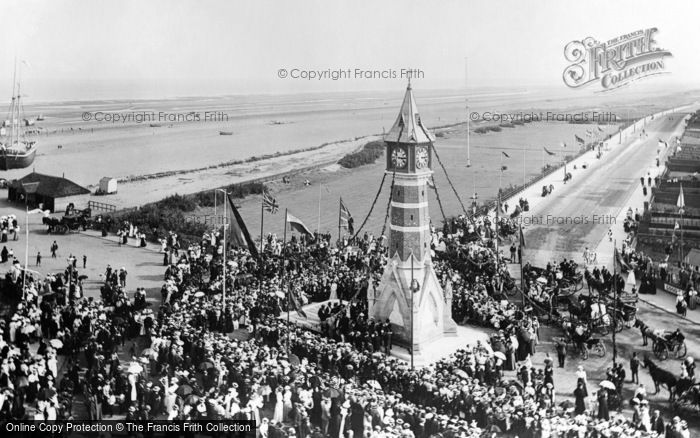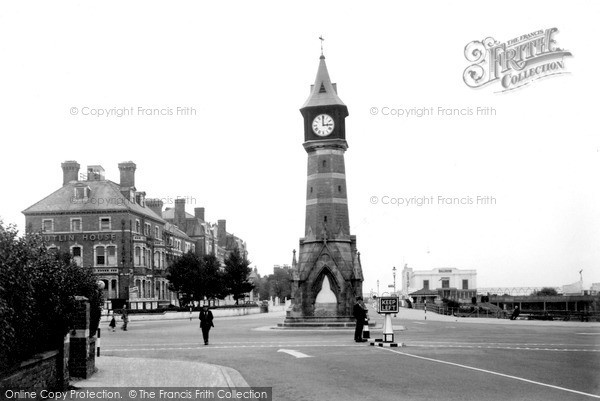Wednesday, 13 January 2010
skegness
Skegness, Official Opening of the Clock Tower 1899

Reproduced courtesy of Francis Frith.
Skegness, the Clock Tower c1955

Reproduced courtesy of Francis Frith.
Early history
The name indicates that Skegness has its origin in the Danish period of settlement in England. Local historians say that the town took its name from Skeggi (meaning 'bearded one'), one of the Vikings who established the original settlement which has since been washed away by the sea. However, it is much more likely to have derived from words which appear in modern Danish as skæg, beard and næs, nose or in geographical terms, headland.
Lying within the historic county boundaries of Lincolnshire from a very early time, for governance, the parish of Skegness was in the Marsh division of the ancient Candleshoe Wapentake in the Parts of Lindsey.
Longshore drift carries particles of sediment southwards along the Lincolnshire coast but at Skegness, the sand settles out in banks (tombolos) which run at a slight angle to the coast forming the beard. The slightly elevated dune land sheltered the small natural harbour which the Danes found behind the banks. The finer sediment drifts on to find a home in the mud of The Wash, beyond Gibraltar Point.
In August 1642, a consignment of arms and money, probably raised by Queen Henrietta Maria, in the Netherlands for the support of King Charles I's campaign in the Civil War, was forced into Skegness by the ships of the Parliamentarian Earl of Warwick.
Skegness was primarily a fishing village and small port until the arrival of the railway in 1875. In 1908, Great Northern Railways commissioned a poster to advertise excursions to the resort, the first being from King's Cross, London on Good Friday 1908, leaving London at 11.30 am. The 'Skegness is so Bracing' poster featuring The Jolly Fisherman helped to put Skegness on the map and is now world famous. The poster, derived from an oil painting by John Hassall (illustrator), was purchased by the railway company for the 12 guineas. Paradoxically, Mr Hassall did not visit the resort until 1936. He is said to have died penniless.
Resort town and Butlins
Most of the land in what is now the downtown core formed part of the estate of the Earl of Scarbrough and he, together with his agent H.V.Tippet, realised that the extensive sandy beach could be made attractive to holidaymakers from the industrial towns of the English Midlands, a clientele already developed by Thomas Cook. He planned the town as a resort from 1877 and it expanded rapidly, but along with many other UK resorts, especially those on the cold North Sea, it lost out to the cheap package holiday boom which opened up Spain (in particular) to the average holidaymaker after World War II currency restrictions were lifted and travellers could leave the UK with more than 50 pounds.
Ingoldmells, the parish to the north of Skegness, was the site of the UK's first Holiday Camp, started by Billy Butlin in 1936. Butlins is still there today, in modern dress, at the north end of the town, on the road to Ingoldmells. It maintains its appeal as a popular destination for family holidays, and attracts thousands to the resort in the low season with music weekends encompassing 60s, 80s, soul and other genres.
The Wash Incident
The Wash Incident took place in the early hours of 5 October 1996 when a strange red and green rotating light was seen by many Skegness residents and police officers to the southeast of Skegness, who then contacted the Coastguard at Great Yarmouth. It later involved many RAF stations, including RAF Neatishead, and GCHQ. The object was not an aircraft because although it could be seen on radar, it had no transponder. The Skegness News, a local newspaper which no longer exists, investigated the incident and sought confirmation of the object from the Jodrell Bank Observatory. In their report to the RAF, the observatory said that Venus, ‘the queen of UFOs’, which had been shining with exceptional brilliance in the early morning sky to the east, probably explained the light shown on the video.
Present day
In March 2005, Skegness took the top spot in a survey by "Yours magazine", looking at the best retirement places in the UK. Yours researchers visited sixty likely towns, and factors involved in judging included house prices, hospital waiting lists, the crime rate, council tax rates, activities and attractions, weather patterns and ease of transport. It has also been described by Lonely Planet's Great Britain guide as "everything you could want" in a seaside resort. On 22 July 2008 the newly elected Mayor of London, Boris Johnson, caused controversy in an article in the Daily Telegraph where he declared "Stuff Skegness, my trunks and I are off to the sun" in his desire to have a foreign holiday this year.
http://en.wikipedia.org/wiki/Skegness

Reproduced courtesy of Francis Frith.
Skegness, the Clock Tower c1955

Reproduced courtesy of Francis Frith.
Early history
The name indicates that Skegness has its origin in the Danish period of settlement in England. Local historians say that the town took its name from Skeggi (meaning 'bearded one'), one of the Vikings who established the original settlement which has since been washed away by the sea. However, it is much more likely to have derived from words which appear in modern Danish as skæg, beard and næs, nose or in geographical terms, headland.
Lying within the historic county boundaries of Lincolnshire from a very early time, for governance, the parish of Skegness was in the Marsh division of the ancient Candleshoe Wapentake in the Parts of Lindsey.
Longshore drift carries particles of sediment southwards along the Lincolnshire coast but at Skegness, the sand settles out in banks (tombolos) which run at a slight angle to the coast forming the beard. The slightly elevated dune land sheltered the small natural harbour which the Danes found behind the banks. The finer sediment drifts on to find a home in the mud of The Wash, beyond Gibraltar Point.
In August 1642, a consignment of arms and money, probably raised by Queen Henrietta Maria, in the Netherlands for the support of King Charles I's campaign in the Civil War, was forced into Skegness by the ships of the Parliamentarian Earl of Warwick.
Skegness was primarily a fishing village and small port until the arrival of the railway in 1875. In 1908, Great Northern Railways commissioned a poster to advertise excursions to the resort, the first being from King's Cross, London on Good Friday 1908, leaving London at 11.30 am. The 'Skegness is so Bracing' poster featuring The Jolly Fisherman helped to put Skegness on the map and is now world famous. The poster, derived from an oil painting by John Hassall (illustrator), was purchased by the railway company for the 12 guineas. Paradoxically, Mr Hassall did not visit the resort until 1936. He is said to have died penniless.
Resort town and Butlins
Most of the land in what is now the downtown core formed part of the estate of the Earl of Scarbrough and he, together with his agent H.V.Tippet, realised that the extensive sandy beach could be made attractive to holidaymakers from the industrial towns of the English Midlands, a clientele already developed by Thomas Cook. He planned the town as a resort from 1877 and it expanded rapidly, but along with many other UK resorts, especially those on the cold North Sea, it lost out to the cheap package holiday boom which opened up Spain (in particular) to the average holidaymaker after World War II currency restrictions were lifted and travellers could leave the UK with more than 50 pounds.
Ingoldmells, the parish to the north of Skegness, was the site of the UK's first Holiday Camp, started by Billy Butlin in 1936. Butlins is still there today, in modern dress, at the north end of the town, on the road to Ingoldmells. It maintains its appeal as a popular destination for family holidays, and attracts thousands to the resort in the low season with music weekends encompassing 60s, 80s, soul and other genres.
The Wash Incident
The Wash Incident took place in the early hours of 5 October 1996 when a strange red and green rotating light was seen by many Skegness residents and police officers to the southeast of Skegness, who then contacted the Coastguard at Great Yarmouth. It later involved many RAF stations, including RAF Neatishead, and GCHQ. The object was not an aircraft because although it could be seen on radar, it had no transponder. The Skegness News, a local newspaper which no longer exists, investigated the incident and sought confirmation of the object from the Jodrell Bank Observatory. In their report to the RAF, the observatory said that Venus, ‘the queen of UFOs’, which had been shining with exceptional brilliance in the early morning sky to the east, probably explained the light shown on the video.
Present day
In March 2005, Skegness took the top spot in a survey by "Yours magazine", looking at the best retirement places in the UK. Yours researchers visited sixty likely towns, and factors involved in judging included house prices, hospital waiting lists, the crime rate, council tax rates, activities and attractions, weather patterns and ease of transport. It has also been described by Lonely Planet's Great Britain guide as "everything you could want" in a seaside resort. On 22 July 2008 the newly elected Mayor of London, Boris Johnson, caused controversy in an article in the Daily Telegraph where he declared "Stuff Skegness, my trunks and I are off to the sun" in his desire to have a foreign holiday this year.
http://en.wikipedia.org/wiki/Skegness
Subscribe to Comments [Atom]
Post a Comment